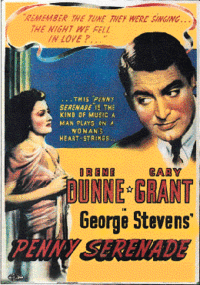George Stevens, dir., Penny Serenade
film review by S. Michael Leier

|
|
Penny Serenade
Directed by George StevensProduced by George Stevens Written by: Martha Cheavens (original story) Morrie Ryskind (screenplay) Starring: Irene Dunne, Cary Grant Music by W. Franke Harling Cinematography by Joseph Walker Distributed by Columbia Pictures Release date: 1941 Running time: 119 min. |
As a writer, one of the toughest things for me to do is to write character development paragraphs. Those sometimes-long sentences about what the character is feeling and how they got to the conflict in the story. I always want to get right into the action, go to the peak of the mountain if you will and leave how they got there behind.
Fortunately, I learned a long time ago that the journey is as important if not more important then the destination. So I look for, in movies and books, how others convey that journey. One movie in particular really helped me to see that journey in a well-written, well-acted form.
The title of the movie is Penny Serenade starring Cary Grant and Irene Dunne and was released by Columbia Pictures in 1941. It was written by Martha Cheavens and Morry Ryskin. Cary Grant received an Oscar nomination for Best Actor, but the award was eventually given to Gary Cooper for his excellent portrayal of Sergeant Alvin York.
Penny Serenade is a story told in flashback as Julie (Irene Dunne) plays song after song on an old phonograph bringing back memories of her past with husband Roger (Cary Grant). Each melody brings to her mind events that will eventually lead to a tragic loss.
The memories always start happy in the beginning, but the viewer begins to understand that each will end in misfortune. Such as when the couple move to Japan and live happily until an earthquake injures Julie, causing her to lose their unborn child and robbing her of the ability to have more.
Roger quits his job as a reporter for a major newspaper and begins his own in small town. His enthusiasm for the newspaper is not enough to make it a viable business and it begins to lose money. Through this sadness, they decide to adopt a child, thinking that that is the missing element in their lives. They struggle through the process and red tape to get custody of a little girl. Roger works harder at this then he has for anything in his life.
One particular scene will rip at your heart when Roger must face a judge and explain how he expects to keep the adopted child when he has no income from his business. It is a gut-wrenching scene as we see a man, whose self-indulgence has placed his family in jeopardy, beg to keep his little girl. It is a strong turning point in the life of this proud man who has finally realized what is really important to him. Alas, more tragedy is in the cards for this struggling family.
This is a dark drama of struggle, enlightenment, and redemption. It will grab at the strongest of hearts and will make the viewers ask themselves What is really important in their lives. It is also a great example of how to build characters within a story that will grab the viewer or reader. It really helped me to understand the strength of the journey to give the destination its larger meaning.
The path taken to reach a particular point gives a purpose to the destination, a meaning to the ending, and reasoning for the joy or sorrow when the journey has come to a close. It is the road taken that brings all the baggage necessary to make the conclusion as powerful as it can be.
I highly recommend this movie for its pure entertainment factor and the lessons learned in the depth of the characters.
Copyright © 2006 by S. Michael Leier

